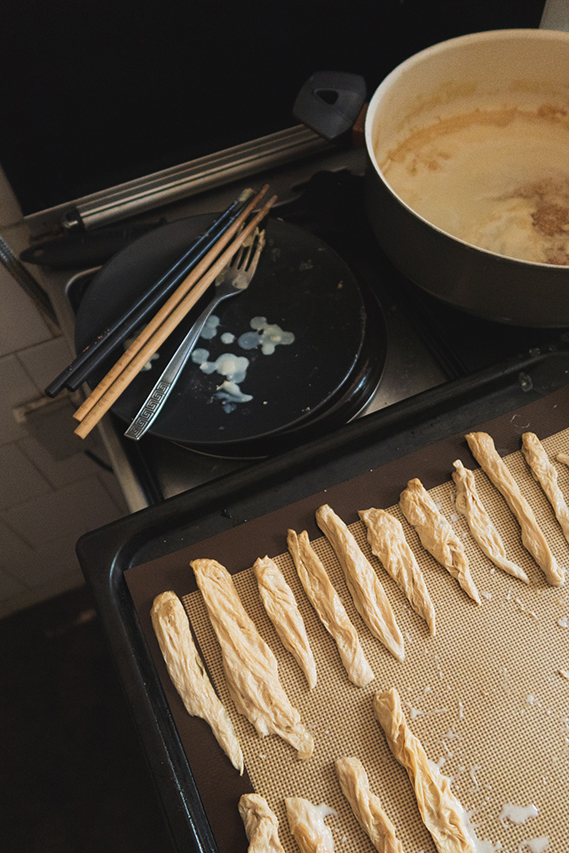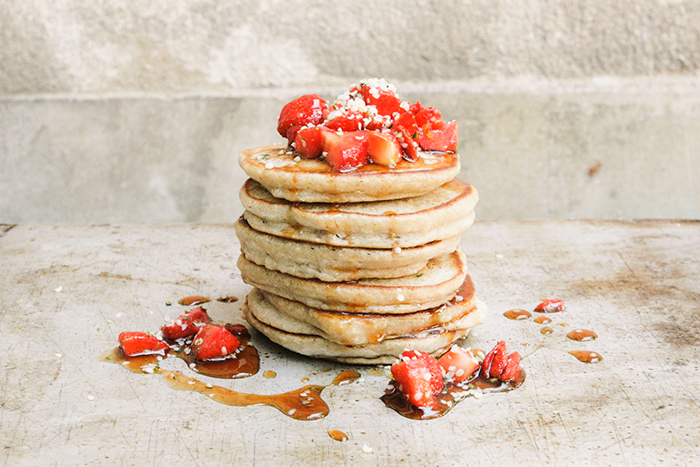Homemade Yuba (Tofu Skins)
In this recipe, I will show you how to make yuba (tofu skins) at home from scratch – from soybeans and water. The whole process is easy and fun, resulting in amazing homemade tofu skins that can be used in many delicious dishes.

What is tofu skin?
Tofu skin is a foodstuff made from soy, that is used in a variety of dishes. It is also called yuba or bean curd skin and is made by slowly cooking soy milk over low heat. Its neutral flavour and pleasant texture make it a fantastic and versatile ingredient for many recipes.
Tofu skins come in the form of wrinkled or straight sheets with a high proportion of soy protein. You can usually buy them dried. Just like tofu, yuba doesn’t have much of its own flavour. Instead, it absorbs the flavours of the marinade or sauce that you cook it in.
Originally from China, yuba (tofu skins) have been used in many Asian cuisines as an ingredient in various dishes. I first tried them in Vietnam, in some tasty meals that we ate in local vegan restaurants.

I loved the unique texture of tofu skins, something between tender and chewy, and not that easy to describe to someone who hasn’t tried it. Pretty plain in flavour by itself, yuba soaks up the flavour from the dish, so it goes well in soups or stir-fry dishes with sauce and spices.
One of my favourite ways to prepare homemade yuba is the one that I described in this braised yuba recipe with vegetables – it is simply braised in a pan with vegetables and shoyu.

Making yuba (tofu skins) at home
Tofu skins (yuba) are pretty easy and fun to make, and all you need are soybeans and water. The soybeans need to be soaked and then blended and strained, to get the raw soy milk.
This soy milk is then cooked over a low heat, until the skin forms on top. This skin is your tofu skin or yuba – you need to carefully remove it from the surface and set it aside to dry. You will need to repeat this process until you spend all the soy milk.
If you made enough yuba before you run out of soy milk, you can just save that milk and leave it for coffee or to use in other recipes.

Drying and storing tofu skins
Yuba can be eaten fresh, or dried for later. I normally either leave them on a silicone sheet until dry, put them in a dehydrator, or hang them over a wooden stick (a simple bamboo chopstick leaning on some kitchen equipment will work).
Dried tofu skins can be kept in a closed glass jar. To use them in recipes, you will need to rehydrate them in cold water overnight, or until they soften.
Another way to rehydrate them and marinate in the same way is to use a 1:1 water and shoyu mixture and soak the dried yuba overnight.
How to cook tofu skin
Tofu skins can be used in many dishes, some of the most popular ones being vegetable stir-fries. Dried tofu skins need to be soaked – either in water or in a mixture of water, soy sauce and spices (I usually prefer the latter for the most delicious result).
Soaking time for tofu skins depends on their thickness and texture. If you are using the wrinkled tofu skin “sticks”, they’ll most likely need to be soaked for six to eight hours to soften and be ready for cooking.
Rehydrated and softened yuba (tofu skin) is ready for cooking – the best way is to braise them in a simmering liquid containing soy sauce, broth and spices over low heat for about fifteen to twenty minutes. Tofu skins will absorb the flavours from the cooking liquid, which will make them extra tasty.
Try this simple recipe for braised tofu skins with vegetables – it is an excellent way to cook tofu skins.
Tofu skins nutrition
Just like tofu, yuba (tofu skin) is an excellent source of plant-based protein. For that reason, it is often used in vegetarian and vegan dishes to make them more nutritious. Yuba provides essential amino acids that our bodies need for growth, repair and overall health.
Tofu skins also contain minerals such as calcium, iron, manganese, selenium and copper, as well as certain vitamins.
Soy products are also known to contain isoflavones – natural plant compounds that act as protective molecules, minimising oxidative damage to the cells in the human body.
Where to buy tofu skins?
Tofu skins can usually be bought in Asian food stores, or ordered online. They are still not as popular worldwide as tofu, so I didn’t find many organic options. Still, one thing you can make sure of when purchasing soy products is that they are GMO-free.
These are some of the good, non-GMO tofu skins available online.
Homemade Yuba (Tofu Skins)

Learn how to make tofu skins, also known as yuba or bean curd skins. They are easy to make at home from soybeans and water. Homemade yuba can be used fresh or dried - it is a fantastic ingredient for many recipes.
Ingredients
- 1/2 cup dried soy beans
- 3 cups water
Instructions
Soak the soy beans in water for at least 12 hours.*
Drain the soaked beans and put them in a blender with 3 cups of water.
Blend for a couple of minutes, until it gets smooth.
Strain the soy milk through a kitchen cloth or a cheesecloth.**
Pour the soy milk into a pot, cook on the lowest heat and stir while bringing it near the boiling temperature.
It should not be visibly boiling, the surface sould stay more or less steady after you stop stirring. If your stove doesn't have such a low fire, you can use a double boiler instead - just pour some water in a larger pot and let it boil under the pot with your soy milk. That way you will also avoid the bottom getting burnt.
Stop stirring and let the soy milk cook. You will notice a skin forming on its surface.
Touch it with a chopstick to check its consistency, and if it is thick enough to handle, lift it up with a chopstick from underneath.
Drain it and put it on a plate.
You will have a new skin form every couple of minutes, so you can repeat this process until you have the desired amount of skins.
You can save the rest of the soy milk and use it as you usually would. This is a cool way of getting both soy milk and yuba, since soy milk needs to be cooked before consuming anyway.
You can eat freshly made tofu skins with some soy sauce and roasted sesame, cook them in a stir-fry or a soup, or dry them and save for later.***
Notes
*I usually soak the beans for 24 hours at room temperature, and if I don't have time to use them right away, I change the soaking water and put them in the fridge (the soaking water can be used for watering plants).
**You can save the okara (solid leftovers) and use it in the baking, or simply compost it.
***I really like them when they have been fully dried (i use a dehydrator, but you can let them dry in the air too) and then rehydrated. They get a chewier consistency than the fresh ones, and you can also give them some extra flavour by soaking them in water with spices or soy sauce.







